User Opinions
|
||||||||||
|
|
|
| Wed Sep 17, 2008 - 7:45 AM EDT - By Andre Kibbe | |
|
|
|
|
|||||||||||
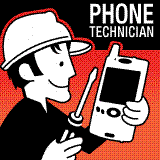
Take a look through TreoCentral or any other Treo forum, and you'll inevitably find a smattering of disgruntled users legitimately taking Palm to task for not updating their operating system, not updating their desktop, not implementing multitasking, WiFi, A2DP, touchscreens, and a host of other features being rolled out on competing cell phones by the minute. Technology seems to be passing Palm by.
What annoys me more are the little things that seem like easy fixes: having to click OK on the Centro's Call has ended dialog, having to add an adapter to make standard headsets compatible with the phone's 2.5mm jack, having to repeat myself over the phone due to an insufficient maximum volume.
Phone Technician is a handy little toolkit for fixing a few annoyances that should have never required an aftermarket solution in the first place. Technician has the following utilities:
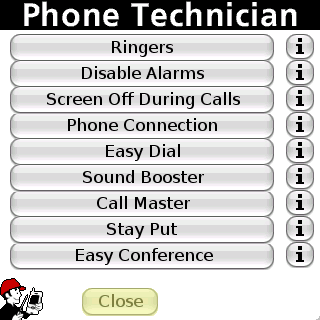
Unlike some utility packs, Phone Technician is a single app with individually named functions in its own launcher, not unlike mTools. Hobbyist Software also bundles Technician in a suite called TreoTastic Bundle, featuring their most popular app, Butler, along with Genius! and Reset Doctor.
The app is downloaded as a single .prc. There's no readme or help document. But most of the tools are fairly intuitive, and each one has an Info page with sufficient instructions beside its launcher button. As with Butler, each screen adds a dash of charm by featuring an icon of your faithful servant in the corner � replacing the butler this time around with a technician in a hard hat handling a Treo.
Let's take a look at each of these individually.
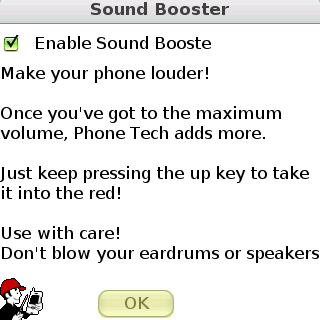
This is, hands down, the reason to get Technician. Everything else is gravy. I had pretty much resigned myself to raising my voice and repeating myself on every phone call before using this utility. I haven't used VolumeCare, which appears to have a few more features, not to mention a great reputation. Sound Booster, on the other hand has all of one parameter: an Enable Sound Booster checkbox. It works dramatically well, as if I'm using a completely different phone. A great value at $14.95, notwithstanding the rest of Technician.
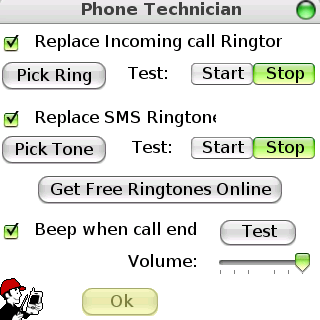
As the title suggests, Ringers is a ringtone manager. Its functionality is pretty basic. Unlike RingCare, you can't assign different ringtones to different callers, nor can you override the Treo's global Prefs settings (you'll need to disable conflicting settings directly in Prefs). Ringers has one tone assignment for phone calls, and another for text messages.
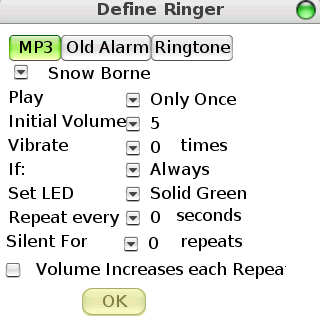
There are three audio types to choose from. What Ringers calls "Ringtones" are the polyphonic MIDI ringtones found on the 650 and later Treos. The "Old Alarm" option refers to the monophonic MIDI ringtones of the Treo 600. The "MP3" type is a proxy for three recorded formats: MP3, OGG and WAV. Sorry, no AAC support. If MIDI rings are still your thing, Ringers features a Get Free Ringtones Online button that takes you to MIDIsite for � you guessed it! � free MIDI ringtones.
You can set the number of repetitions, repetition interval, LED behavior, initial volume, volume increase with each repetition, and the option to accompany with vibration. Ringers in conjunction with Sound Booster is distinctly more audible than most ringtone managers, which is not a trivial advantage. Most people who go to the trouble of customizing their ringtones want other people to hear them (unfortunately).
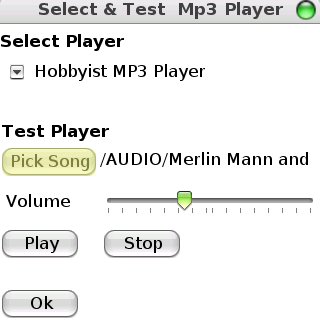
For some reason, Hobbyist's product page contains the bullet point "Includes Built in MP3 Player - no need to purchase a separate MP3 player." Yes, there's a MP3 player within Technician. You have to access it from the menu instead of the launcher. But this "player" is apparently little more than an engine for playing MP3 ringtones. Otherwise Ringers has to use another installed player, like pTunes or MMPlayer. You can only use Technician's MP3 player for tracks in RAM � not from the card. The fact that I was able to access my existing /Ringtones subfolder from the card was probably attributable to having pTunes installed.
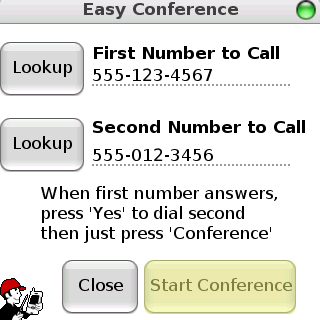
Here's one of those easily programmable, "Why didn't Palm think of that?" interface designs. Instead of making a conference call by making the first call, then dialing the second party while on the line with the first, Easy Conference takes a simpler approach. Its dialer screen allows you to look up and enter the first number, then the second; then you initiate the call by tapping the Start Conference button. When the first number answers, you press Yes to dial and start the second number, so that you're not looking it up during the call, then press Conference. It makes you actually want to use the Treo's three-way calling feature.
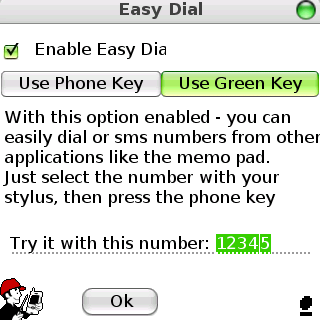
In cases where a phone number embedded in an email, memo or some other record where the number isn't hyperlinked for automatic dialing, Easy Dial allows you to highlight the number with the stylus and call or text it without having to copy and paste. You can set either the Talk button or the Phone button to launch the call or SMS.
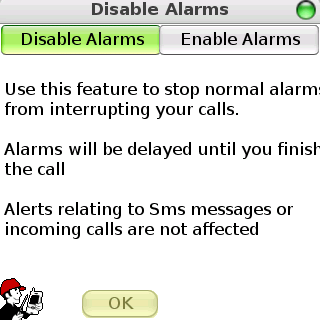
Disable Alarms prevents any scheduled alarms from going off during an active phone call. It's more accurate to say it defers any scheduled alarms until the calls have ended, so you don't have to worry about missing them. Nor do you have to worry about missing phone calls or texts. Disable Alarms doesn't affect alerts from incoming calls or text messages.
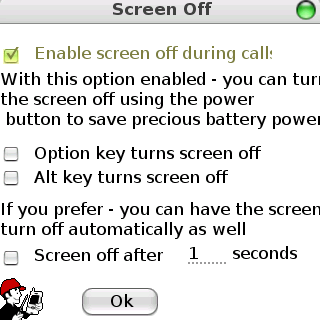
Simple but not trivial. This turns off the screen during phone calls � a huge battery saver. Now when I talk on a cell phone at the movies, other people in the audience are only annoyed by my voice, not the glowing screen.
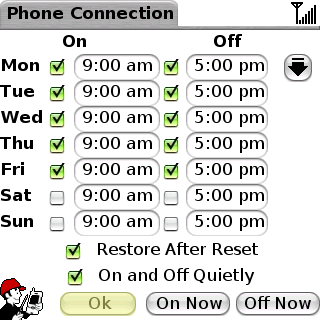
Another battery saver. This one turns the connection on or off, now or at scheduled intervals. You can either duplicate the schedule you set for Monday to apply through the rest of the week, or you can set the days individually. Phone Connection can automatically restore the connection after a reset, or deactivate the chime that accompanies the connection turning on or off.
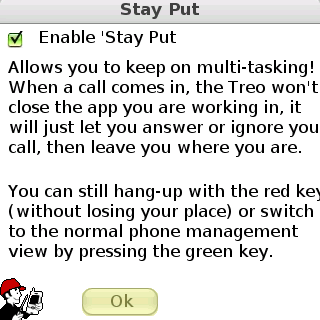
There's nothing more annoying than a call from the Emergency Room interrupting a good round of Sudoku. Check Enable Stay Put, and you can answer or ignore the call without leaving the current app. You can still use the End button to hang up, or switch to the standard dialer app with the Talk button.
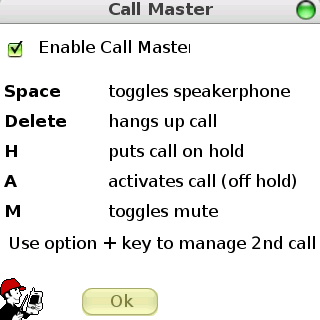
If you've resisted That Other Phone thus far, you're probably not enamoured of touchscreens. Call Master transfers call management down to the keyboard. The spacebar toggles the speakerphone, and the backspace key hangs up a call (not much advantage, being next to the End button). The H, A and M mnemonics take a little getting used to. The H and M are logical enough: Hold and Mute. The A is for "Activate," meaning "take off hold."
The flagship utility here is Sound Booster, but none of the others are fluff. They all do simple, needed functions and settings in an easy to use fashion. It might have been better not to advertise "An MP3 player" then include one that only plays from internal memory, but it's not a make-or-break feature. Considering that Sound Booster is cheaper than its single-tasking competition, Phone Technician has a great bang-for-the buck factor.
|
|
||||||||||||||||||||
|
Copyright 1999-2016 TreoCentral. All rights reserved :
Terms of Use : Privacy Policy
TREO and TreoCentral are trademarks or registered trademarks of palm, Inc. in the United States and other countries;
the TreoCentral mark and domain name are used under license from palm, Inc.
The views expressed on this website are solely those of the proprietor, or
contributors to the site, and do not necessarily reflect the views of palm, Inc.
Read Merciful by Casey Adolfsson